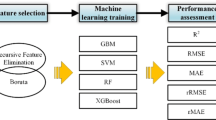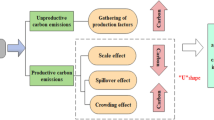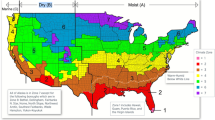Abstract
The precise and exhaustive discernment of factors influencing CO2 emissions underpins the advancement toward sustainable, low-carbon development. Although numerous studies have probed the correlation between predetermined proxy variables and carbon emissions, methodological constraints have often led to an inability to effectively discern carbon emission determinants among numerous potential variables or unravel complex, non-linear relationships, and interaction effects. To redress these research gaps, this research utilized machine learning models to correlate urban CO2 emissions with socioeconomic indicators. The model outputs were then visualized and interpreted using explainable methods. The findings indicated that the model successfully identified a comprehensive array of dominant influences on urban CO2 emissions, principally associated with local fiscal policies, land use, energy consumption, industrial development, and urban transportation. The findings further revealed a complex non-linear association between these factors and urban CO2 emissions; however, the majority of these variables displayed a prevalent propensity to intensify carbon emissions in correspondence with an increase in sample value. Additionally, these factors exhibited a complex interactive influence on urban CO2 emissions, with distinct pairings producing a suppressive effect exclusively at specific combination of sample values. Consequently, this research posited that a robust correlation between urban socioeconomic development and CO2 emissions in China remains to be established. Given the varied impacts of these influencing factors across different cities, a differentiated approach to development should be adopted when charting low-carbon trajectories.








Similar content being viewed by others
Data availability
The datasets used and/or analyzed during the current study/Supplementary Materials are available from the corresponding author upon reasonable request.
References
Abeydeera L, Mesthrige JW, Samarasinghalage TI (2019) Global research on carbon emissions: a scientometric review. Sustainability 11
Abid M (2016) Impact of economic, financial, and institutional factors on CO2 emissions: evidence from Sub-Saharan Africa economies. Utilities Policy 41:85–94
Al-qaness MAA, Ewees AA, Thanh HV, AlRassas AM, Dahou A, Abd Elaziz M (2023) Predicting CO2 trapping in deep saline aquifers using optimized long short-term memory. Environ Sci Pollut Res 30:33780–33794
Ang BW, Su B (2016) Carbon emission intensity in electricity production: a global analysis. Energy Policy 94:56–63
Apergis N, Ozturk I (2015) Testing environmental Kuznets curve hypothesis in Asian countries. Ecol Indicators 52:16–22
Cansino JM, Sanchez-Braza A, Rodriguez-Arevalo ML (2015) Driving forces of Spain’s CO2 emissions: a LMDI decomposition approach. Renew Sustain Energy Rev 48:749–759
Chen C, Zhang Q, Yu B, Yu Z, Lawrence PJ, Ma Q, Zhang Y (2020a) Improving protein-protein interactions prediction accuracy using XGBoost feature selection and stacked ensemble classifier. Comput Biol Med 123:103899
Chen JD, Wang P, Cui LB, Huang S, Song ML (2018) Decomposition and decoupling analysis of CO2 emissions in OECD. Appl Energy 231:937–950
Chen PP, Wu Y, Zhong HL, Long Y, Meng J (2022) Exploring household emission patterns and driving factors in Japan using machine learning methods. Appl Energy 307
Chen WY (2015) The role of urban green infrastructure in offsetting carbon emissions in 35 major Chinese cities: a nationwide estimate. Cities 44:112–120
Chen X, Shuai CY, Wu Y, Zhang Y (2020b) Analysis on the carbon emission peaks of China’s industrial, building, transport, and agricultural sectors. Sci Total Environ 709
Cheng SL, Fan W, Meng FX, Chen JD, Liang S, Song ML, Liu GY, Casazza M (2021) Potential role of fiscal decentralization on interprovincial differences in CO2 emissions in China. Environ Sci Technol 55:813–822
CoreWritingTeam (2014) Climate Change 2014: synthesis report. Contribution of working groups I, II and III to the fifth assessment report of the intergovernmental panel on climate change. IPCC, Geneva, Switzerland
Corner SP (2022) The sixth major IPCC assessment report and its implications: 15 September 2021. Weather 77:70–71
Dai HB, Huang GQ, Wang JJ, Zeng HB, Zhou FY (2022) Regional VOCs gathering situation intelligent sensing method based on spatial-temporal feature selection. Atmosphere 13:483
Davoodi S, Thanh HV, Wood DA, Mehrad M, Rukavishnikov VS, Dai ZX (2023) Machine-learning predictions of solubility and residual trapping indexes of carbon dioxide from global geological storage sites. Exp Syst Appl 222:119796
Deng JQ, Zhang N, Ahmad F, Draz MU (2019) Local government competition, environmental regulation intensity and regional innovation performance: an empirical investigation of Chinese provinces. Int J Environ Res Public Health 16:2130
Dogan E, Aslan A (2017) Exploring the relationship among CO2 emissions, real GDP, energy consumption and tourism in the EU and candidate countries: evidence from panel models robust to heterogeneity and cross-sectional dependence. Renew Sustain Energy Rev 77:239–245
Dogan E, Seker F (2016) Determinants of CO2 emissions in the European Union: the role of renewable and non-renewable energy. Renew Energy 94:429–439
Dong K, Hochman G, Timilsina GR (2020) Do drivers of CO2 emission growth alter overtime and by the stage of economic development? Energy Policy 140:111420
Du JT, Sun YH (2021) The nonlinear impact of fiscal decentralization on carbon emissions: from the perspective of biased technological progress. Environ Sci Pollut Res 28:29890–29899
Elzen M, Fekete H, Höhne N, Admiraal A, Forsell N, Hof AF, Olivier JGJ, Roelfsema M, van Soest H (2016) Greenhouse gas emissions from current and enhanced policies of China until 2030: can emissions peak before 2030? Energy Policy 89:224–236
Friedlingstein P et al (2020) Global carbon budget 2020. Earth System Sci Data 12:3269–3340
Frieman JH, Popescu BE (2008) Predictive learning via rule ensembles. Ann Appl Stat 2:916–954
Gao P, Yue SJ, Chen HT (2021) Carbon emission efficiency of China’s industry sectors: from the perspective of embodied carbon emissions. J Clean Prod 283:124655
Gong WQ, Kong Y (2022) Nonlinear influence of Chinese real estate development on environmental pollution: new evidence from spatial econometric model. Int J Environ Res Public Health 19:588
Gu B, Sheng VS, Wang ZJ, Ho D, Osman S, Li S (2015) Incremental learning for nu-support vector regression. Neural Networks 67:140–150
Gu JX, Wang ZH, Kuen J, Ma LY, Shahroudy A, Shuai B, Liu T, Wang XX, Wang G, Cai JF, Chen T (2018) Recent advances in convolutional neural networks. Pattern Recognition 77:354–377
He LY, Yin F, Zhong ZQ, Ding ZH (2017a) The impact of local government investment on the carbon emissions reduction effect: an empirical analysis of panel data from 30 provinces and municipalities in China. Plos One 12:e0180946
He Z, Xu S, Shen W, Long R, Chen H (2017b) Impact of urbanization on energy related CO2 emission at different development levels: regional difference in China based on panel estimation. J Clean Prod 140:1719–1730
Huo T, Li X, Cai W, Zuo J, Jia F, Wei H (2020) Exploring the impact of urbanization on urban building carbon emissions in China: evidence from a provincial panel data model. Sustain Cities Soc 56:102068
Jiang TY, Yu Y, Jahanger A, Balsalobre-Lorente D (2022) Structural emissions reduction of China's power and heating industry under the goal of “double carbon”: a perspective from input-output analysis. Sustain Prod Consumpt 31:346–356
Kang Y-Q, Zhao T, Yang Y-Y (2016) Environmental Kuznets curve for CO2 emissions in China: a spatial panel data approach. Ecol Indicators 63:231–239
Kotsiantis SB (2013) Decision trees: a recent overview. Artif Intell Rev 39:261–283
Kurokawa J, Ohara T, Morikawa T, Hanayama S, Janssens-Maenhout G, Fukui T, Kawashima K, Akimoto H (2013) Emissions of air pollutants and greenhouse gases over Asian regions during 2000-2008: Regional Emission inventory in ASia (REAS) version 2. Atmos Chem Phys 13:11019–11058
Lamb WF et al (2022) A review of trends and drivers of greenhouse gas emissions by sector from 1990 to 2018 (vol 16, 073005, 2021). Environ Res Lett 17
Le Quere C et al (2018) Global Carbon Budget 2018. Earth Syst Sci Data 10:2141–2194
Lee S, Lee B (2014) The influence of urban form on GHG emissions in the US household sector. Energy Policy 68:534–549
Li ML, Wang W, De G, Ji XH, Tan ZF (2018) Forecasting carbon emissions related to energy consumption in Beijing-Tianjin-Hebei region based on grey prediction theory and extreme learning machine optimized by support vector machine algorithm. Energies 11(9):2475
Li PY, Wang ZH (2021) Environmental co-benefits of urban greening for mitigating heat and carbon emissions. J Environ Manage 293
Li Y, Du Q, Lu XR, Wu J, Han X (2019) Relationship between the development and CO2 emissions of transport sector in China. Transport Res Part D-Transport Environ 74:1–14
Li Y, Yang XD, Ran QY, Wu HT, Irfan M, Ahmad M (2021) Energy structure, digital economy, and carbon emissions: evidence from China. Environ Sci Pollut Res 28:64606–64629
Lin BQ, Ma RY (2022) Green technology innovations, urban innovation environment and CO2 emission reduction in China: fresh evidence from a partially linear functional-coefficient panel model. Technol Forecast Soc Change 176:121434
Lin BQ, Omoju OE, Nwakeze NM, Okonkwo JU, Megbowon ET (2016) Is the environmental Kuznets curve hypothesis a sound basis for environmental policy in Africa? J Clean Prod 133:712–724
Lin S, Wang S, Marinova D, Zhao D, Hong J (2017) Impacts of urbanization and real economic development on CO2 emissions in non-high income countries: empirical research based on the extended STIRPAT model. J Clean Prod 166:952–966
Liu N, Ma ZJ, Kang JD (2015) Changes in carbon intensity in China’s industrial sector: decomposition and attribution analysis. Energy Policy 87:28–38
Ma XJ, Wang CX, Dong BY, Gu GC, Chen RM, Li YF, Zou HF, Zhang WF, Li QN (2019) Carbon emissions from energy consumption in China: its measurement and driving factors. Sci Total Environ 648:1411–1420
Mendes-Moreira J, Soares C, Jorge AM, De Sousa JF (2012) Ensemble approaches for regression: a survey. Acm Comput Surveys 45
Mi Z, Wei Y-M, Wang B, Meng J, Liu Z, Shan Y, Liu J, Guan D (2017) Socioeconomic impact assessment of China's CO2 emissions peak prior to 2030. J Clean Prod 142:2227–2236
Molnar C (2022) Interpretable machine learning-a guide for making black box models explainable
Ozcan B (2013) The nexus between carbon emissions, energy consumption and economic growth in Middle East countries: a panel data analysis. Energy Policy 62:1138–1147
Özokcu S, Özdemir Ö (2017) Economic growth, energy, and environmental Kuznets curve. Renew Sustain Energy Rev 72:639–647
Pedregosa F, Varoquaux G, Gramfort A, Michel V, Thirion B, Grisel O, Blondel M, Prettenhofer P, Weiss R, Dubourg V, Vanderplas J, Passos A, Cournapeau D, Brucher M, Perrot M, Duchesnay E (2011) Scikit-learn: machine learning in Python. J Machine Learn Res 12:2825–2830
Pham NM, Huynh TLD, Nasir MA (2020) Environmental consequences of population, affluence and technological progress for European countries: a Malthusian view. J Environ Manage 260:110143
Rock M, Saade MRM, Balouktsi M, Rasmussen FN, Birgisdottir H, Frischknecht R, Habert G, Lutzkendorf T, Passer A (2020) Embodied GHG emissions of buildings - the hidden challenge for effective climate change mitigation. Appl Energy 258:114107
Roscher R, Bohn B, Duarte MF, Garcke J (2020) Explainable machine learning for scientific insights and discoveries. Ieee Access 8:42200–42216
Salahuddin M, Gow J, Ozturk I (2015) Is the long-run relationship between economic growth, electricity consumption, carbon dioxide emissions and financial development in Gulf Cooperation Council Countries robust? Renew Sustain Energy Rev 51:317–326
Sarkodie SA, Strezov V (2018) Empirical study of the environmental Kuznets curve and environmental sustainability curve hypothesis for Australia, China, Ghana and USA. J Clean Prod 201:98–110
Shan YL, Guan DB, Zheng HR, Ou JM, Li Y, Meng J, Mi ZF, Liu Z, Zhang Q (2018) Data descriptor: China CO2 emission accounts 1997-2015. Sci Data 5(1):1–14
Shi X, Zheng Y, Lei Y, Xue W, Yan G, Liu X, Cai B, Tong D, Wang J (2021) Air quality benefits of achieving carbon neutrality in China. Sci Total Environ 795:148784
Shrestha A, Mahmood A (2019) Review of deep learning algorithms and architectures. Ieee Access 7:53040–53065
Sorrell S (2009) Jevons’ Paradox revisited: the evidence for backfire from improved energy efficiency. Energy Policy 37:1456–1469
Sun W, Huang CC (2022) Predictions of carbon emission intensity based on factor analysis and an improved extreme learning machine from the perspective of carbon emission efficiency. J Clean Prod 338
Thanh HV, Taremsari SE, Ranjbar B, Mashhadimoslem H, Rahimi E, Rahimi M, Elkamel A (2023) Hydrogen storage on porous carbon adsorbents: rediscovery by nature-derived algorithms in random forest machine learning model. Energies 16:2348
Wang A, Hu S, Li J (2022) Using machine learning to model technological heterogeneity in carbon emission efficiency evaluation: the case of China’s cities. Energy Econ 114:106238
Wang Y, Han R, Kubota J (2016a) Is there an environmental Kuznets curve for SO2 emissions? A semi-parametric panel data analysis for China. Renew Sustain Energy Rev 54:1182–1188
Wang Z, Zhu YS, Zhu YB, Shi Y (2016b) Energy structure change and carbon emission trends in China. Energy 115:369–377
Wang ZJ, Chen F, Fujiyama T (2015) Carbon emission from urban passenger transportation in Beijing. Transport Res Part D-Transport Environ 41:217–227
Xu G, Dong H, Xu Z, Bhattarai N (2022) China can reach carbon neutrality before 2050 by improving economic development quality. Energy 243:123087
Xu SC, He ZX, Long RY (2014) Factors that influence carbon emissions due to energy consumption in China: decomposition analysis using LMDI. Appl Energy 127:182–193
Yang J, Cai W, Ma MD, Li L, Liu CH, Ma X, Li LL, Chen XZ (2020) Driving forces of China’s CO2 emissions from energy consumption based on Kaya-LMDI methods. Sci Total Environ 711:134569
Yang L, Shami A (2020) On hyperparameter optimization of machine learning algorithms: theory and practice. Neurocomputing 415:295–316
Yao CR, Feng KS, Hubacek K (2015) Driving forces of CO2 emissions in the G20 countries: an index decomposition analysis from 1971 to 2010. Ecol Inform 26:93–100
Yin J, Zheng M, Chen J (2015) The effects of environmental regulation and technical progress on CO2 Kuznets curve: an evidence from China. Energy Policy 77:97–108
Zhang B, Zhang Y, Jiang XC (2022) Feature selection for global tropospheric ozone prediction based on the BO-XGBoost-RFE algorithm. Sci Rep 12:9244
Zhang H, Thanh HV, Rahimi M, Al-Mudhafar WJ, Tangparitkul S, Zhang T, Dai Z, Ashraf U (2023a) Improving predictions of shale wettability using advanced machine learning techniques and nature-inspired methods: implications for carbon capture utilization and storage. Sci Total Environ 877:162944
Zhang M, Liu X, Peng SG (2023b) Effects of urban land intensive use on carbon emissions in China: spatial interaction and multi-mediating effect perspective. Environ Sci Pollut Res 30(3):7270–7287
Zhang N, Yu KR, Chen ZF (2017) How does urbanization affect carbon dioxide emissions? A cross-country panel data analysis. Energy Policy 107:678–687
Zhao JJ, Kou L, Wang HT, He XY, Xiong ZH, Liu CQ, Cui H (2022a) Carbon emission prediction model and analysis in the Yellow river basin based on a machine learning method. Sustainability 14:6153
Zhao X, Ma X, Chen B, Shang Y, Song M (2022b) Challenges toward carbon neutrality in China: strategies and countermeasures. Resour Conserv Recycl 176:105959
Zheng S, Huang YK, Sun Y (2022) Effects of urban form on carbon emissions in China: implications for low-carbon urban planning. Land 11
Zhu YX, Liu ZM, Feng SY, Lu N (2022) The role of fiscal expenditure on science and technology in carbon reduction: evidence from provincial data in China. Environ Sci Pollut Res 29:82030–82044
Funding
This research is supported by Social science funding from the Hubei education department (No. 19Q038).
Author information
Authors and Affiliations
Contributions
Kun Xiang: writing the original draft, software coding, and data analyses, revising the manuscript critically for important content, and English writing. Haofei Yu: resources, revising the manuscript critically for important content. Hao Du: revising the manuscript critically for important content and English writing. Md Hasibul Hasan: software coding and data analyses. Siyi Wei: revising the manuscript critically for important content. Xiangyun Xiang: writing review and editing.
Corresponding author
Ethics declarations
Ethical approval
Not applicable
Consent to participate
Not applicable
Consent for publication
Not applicable
Competing interests
The authors declare no competing interests.
Additional information
Responsible Editor: V.V.S.S. Sarma
Publisher’s note
Springer Nature remains neutral with regard to jurisdictional claims in published maps and institutional affiliations.
Supplementary Information
Below is the link to the electronic supplementary material.
Rights and permissions
Springer Nature or its licensor (e.g. a society or other partner) holds exclusive rights to this article under a publishing agreement with the author(s) or other rightsholder(s); author self-archiving of the accepted manuscript version of this article is solely governed by the terms of such publishing agreement and applicable law.
About this article
Cite this article
Xiang, K., Yu, H., Du, H. et al. Exploring influential factors of CO2 emissions in China’s cities using machine learning techniques. Environ Sci Pollut Res (2023). https://doi.org/10.1007/s11356-023-28285-3
Received:
Accepted:
Published:
DOI: https://doi.org/10.1007/s11356-023-28285-3




